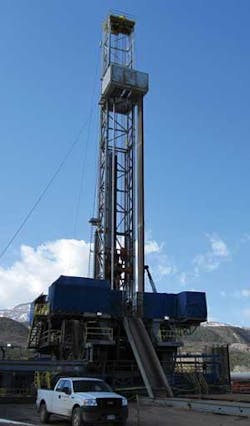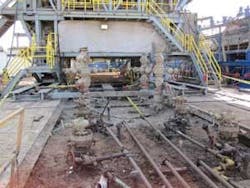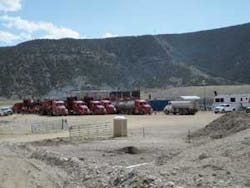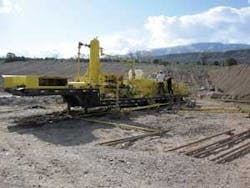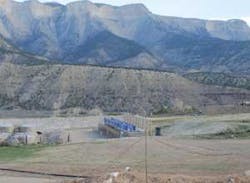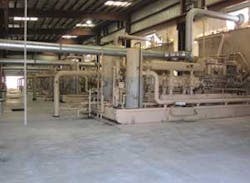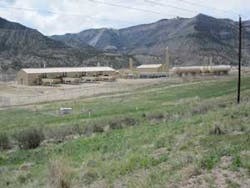Williams Exploration & Production in recent years has changed the way it is developing the tight gas sands in the Piceance basin of Western Colorado. It has started using skidable rigs that can drill up to 22 wells from a single well pad and fracturing operations that can stimulate wells on multiple pads from a central location.
These along with other changes in operations have made the gas development both more efficient and environmentally friendly, according to Williams.
Piceance operations
Williams acquired its interest in the Piceance basin when it purchased Barrett Resources Inc. in 2001. Barrett had drilled its first well in the basin in 1983.
The producing sands are in the Williams Fork member of the Mesa Verde formation.
William operates out of an office in Parachute, Colo., and employs about 250 people in the basin. Its operations are mainly in Garfield County with some also in Rio Blanco County.
Steve Soychak, district manager for Williams, said the company in early 2009 completed its 3,000th gas producing well in the basin compared with having only 400 producers 9 years ago.
The three main fields it is developing are Grand Valley, Parachute, and Rulison.
He noted the basin currently produces about 1.7-1.8 bcfd with Williams producing about 850 MMcfd gross, making Williams the largest producer in the basin.
He said that for 2009 the company has a $500-600 million capital-spending program and will employ 9-10 drilling rigs. Its plans are to drill about 300 wells in 2009, compared with the 600 drilled in 2008 when it had 25 rigs running, Soychak said.
In April 2009, Williams had 9 rigs working in the basin, with 8 in Garfield County and 1 in Rio Blanco County.
He added that Williams has about 7,000 remaining locations to drill in the Williams Fork, as well as potential deeper targets. Williams has not drilled a dry hole in the basin in several years, he said.
Besides the gas wells, Williams operates the Parachute Creek gas plant that has a capacity 1 bcfd throughput capacity and also has under construction the $350 million, 450-MMscfd Willow Creek cryogenic gas processing plant near Meeker that will start operations in third-quarter 2009.
Drilling
Soychak said that drilling during the 1980s and 1990s in the basin typically involved one well from one drilling location or pad. But to minimize land disturbance and gain efficiency, William has started drilling up to 22 wells from a single well pad using skidable drilling rigs similar to ones used offshore, such as the Nabors Drilling USA LP Super Sundowner and the Helmerich & Payne Inc. Flex Rig (Fig. 1). These rigs also have top drives to improve drilling efficiency.
Williams runs a year-round drilling operation with crews working 2 weeks on and 2 weeks off.
The well locations on the pads are 7½ ft apart and form two rows, with 10 ft between rows (Fig. 2).
Soychak said the bottomhole well locations are on 10-acre spacing and produce from sands at 5,000-8,000 ft. The target sands are in the Williams Fork member of the Mesa Verde formation. These are fluvial river channels with coal sections in between sands.
The wells have an S-shape with the bottomhole section 700-2,000 ft away from the wellhead. The bottomhole section is vertical; otherwise, the wells would be too close together, Soychak said.
William aims for a 50-ft target for the bottomhole section and uses mud motors and a 1° bent sub to build angle.
Typically the wells have a 2,500-ft gross pay section containing six to seven producing stages, Soychak said.
Operations involve simultaneous drilling, completion, fracturing, and producing from the well pad. After drilling of the first four wells, hydraulic rams skid the rig back without laying down the 4½-in. drill pipe so that another rig can complete the wells while the skidable rig drills another four wells.
The location can accommodate a completion rig, such as a stand-alone snubbing unit, alongside of the skidable drilling rig.
The drilling requires weighted water-based mud because of overpressured sands, with 9-11 ppg mud in shallower wells and 14-15 ppg mud in deeper wells.
Soychak said the use of skidable rigs has reduced surface disturbance by 75%, for instance one 2-3 acre pad can accommodate up to 22 wells. Williams’s current procedure calls for not bringing the rig back to the location after completing the drilling on a pad and reducing the pad size to less than 1 acre after moving the rig off.
Soychak said average drilling time is 14 days for a 7,000-ft well, but it also can vary depending on the field. For instance, in Parachute it takes 7 days to drill a 6,500-ft well compared with 15 days for an 8,500-ft well in Rulison, he said.
The wells have a standardized tubular size, with a 13⅝-in. conductor, 9⅝-in. surface casing set at about 1,100 ft in a 12¼-in. hole, 4½-in. production casing run in a 7⅞-in. hole, and 2⅜-in. production tubing.
Williams drills the 7⅞-in. hole with polycrystalline diamond compact bits. It disposes of the cutting in an onsite long trench.
Hydraulic fracturing
Soychak said Williams started cluster fracturing about 3 years ago. This involves placing the fracturing equipment in a central location from which the equipment can pump fracturing fluids to wells on multiple well pads (Fig. 3).
The company has fractured wells at distances of more than 3 miles from the centralized frac site and Soychak noted that the centralized sites have reduced truck traffic that can disturb wildlife. The equipment on one location has fraced as many 60 wells, he said.
Soychak says that Williams fracs 50-60 zones/week.
Williams stages the frac jobs with the lowest most zone perforated and hydraulically fractured first.
It typically perforates a zone at 4 shots/ft using a limited entry technique with typically 15-20 shots total and spearheads the frac with 500 gal of 7½% HCl acid.
For hydraulic fracturing, Williams uses a water-based frac fluid with surfactant, biocides, and a friction reducer. The slick water has much less chemical than previously used in frac jobs, Soychak noted.
The surfactant in the frac fluid enhances water recovery, which in turn enchances gas recovery, the biocide controls bacteria growth, and the friction reducers allows for the pumping of fracturing jobs through the 4-in. high-pressure lines at greater distances from the fracturing equipment.
A typical frac job initially pumps the frac fluid with ½ ppg of 20/40 sand before ramping up the sand concentration to 1½ ppg toward the end of the frac. Each frac stage entails pumping 2,000-4,000 bbl of fluid with a maximum pressure of 7,000 psi. Typical pumping rates are 55 bbl/min.
Williams notes that it takes about 3 weeks for the fracturing fluid to flowback. The flowback after fracturing the zone goes through a skid-mounted unit that separates out the gas, condensate, water, and sand (Fig. 4). The use of the separator has eliminated the need to flare gas by 90%, Soychak said.
The separated fluid goes into a closed loop system the recycles the frac fluid for use in subsequent frac job and puts the gas into the field’s gas-gathering system.
Williams obtains water for the frac jobs from evaporation ponds for produced water. It has a 200,000 bbl pond at Parachute and a 500,000 bbl pond at Rulison.
Production
The basin produces sweet gas with about 3% CO2.
The company’s gas producing wells are all on plunger lift. Soychak said the wells produce with a hyperbolic decline that initially starts at 1-1½ MMcfd and drops sharply before entering a long-lived low production rate.
The wells produce against a gathering line pressure of about 250-psi and have initial bottomhole pressures of 2,500-3,500 psi.
The company uses solar panels to power remote terminal units to communicate production information so that operational personnel need to make fewer visits to wellsites (Fig. 5).
Williams has 13 field compressor sites for increasing the gas pressure to the 800 psi needed for the flow into the Parachute Creek gas plants. For flexibility, the gas-gathering system ties all wells and compressor stations together.
The sites have 75 two-stage reciprocating compressors, each of which can compress about 9 MMscfd of gas. The 1,200-hp compressors have a 1,000-hp rating because of the high altitude of the area (Fig. 6).
Williams recently completed the expansion of Parachute Creek Gas Plant 3, increasing total capacity of its four plants at Parachute Creek to 1 bcfd (Fig. 7).
The Parachute Creek gas plants are refrigeration plants that operate at –20° F. compared with the –155° F. operating temperature of the cryogenic turboexpander under construction at Willow Creek.
The company also has four smaller gas plants in the basin, some of which it may phase out.
Williams previously trucked out liquids from the Parachute Creek gas plants but now the liquids enter a pipeline system that moves them to a fractionator in Mount Belvieu, Tex.
Some produced water, which is saline, goes to evaporation ponds and recently because of the reduced drilling and fracturing, Williams has started trucking some water to Cisco, Utah, for disposal.
The Parachute Creek plants have amine units for removing CO2 from the gas.
Williams sells part of the CO2 to a nearby Solvay Chemical Inc. plant that manufactures bicarbonate of soda (baking soda) and reinjects another portion back into the gas to obtain the 2% CO2 pipeline gas specification. It vents the remaining CO2.
Environmental footprint
Some activities that Williams cites as lessening its effects on the environment include:
- Partnering with the Colorado Division of Wildlife to study and track mule deer movement.
- Working with the US Department of the Interior to explore new and improved ways to camouflage energy facilities.
- Recycling as muich produced water as possible for use in other operations.
- Reducing its emissions during the completions process by about 90% through the use of equipment to eliminate flaring.
- Installed telemetry for monitoring and controlling wells to reduce truck traffic.
- Using less land to drill and produce.
It also completed in 2007 a $20 million road tunnel on private land to help reduce traffic on county roads to its Allen Point development area on the Roan plateau.
